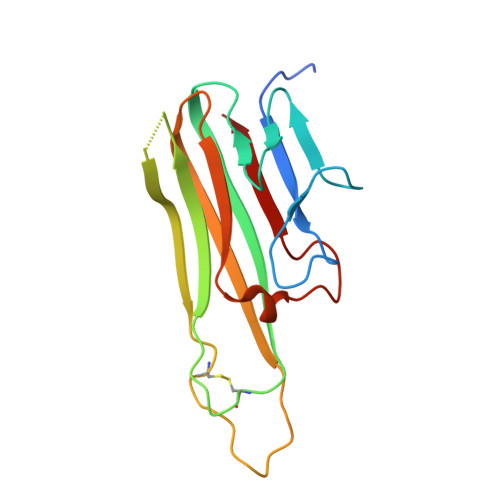Development of Orally Efficacious Allosteric Inhibitors of TNF alpha via Fragment-Based Drug Design.
Dietrich, J.D., Longenecker, K.L., Wilson, N.S., Goess, C., Panchal, S.C., Swann, S.L., Petros, A.M., Hobson, A.D., Ihle, D., Song, D., Richardson, P., Comess, K.M., Cox, P.B., Dombrowski, A., Sarris, K., Donnelly-Roberts, D.L., Duignan, D.B., Gomtsyan, A., Jung, P., Krueger, A.C., Mathieu, S., McClure, A., Stoll, V.S., Wetter, J., Mankovich, J.A., Hajduk, P.J., Vasudevan, A., Stoffel, R.H., Sun, C.(2021) J Med Chem 64: 417-429
- PubMed: 33378180
- DOI: https://doi.org/10.1021/acs.jmedchem.0c01280
- Primary Citation of Related Structures:
6X81, 6X82, 6X83, 6X85, 6X86 - PubMed Abstract:
Tumor necrosis factor α (TNFα) is a soluble cytokine that is directly involved in systemic inflammation through the regulation of the intracellular NF-κB and MAPK signaling pathways. The development of biologic drugs that inhibit TNFα has led to improved clinical outcomes for patients with rheumatoid arthritis and other chronic autoimmune diseases; however, TNFα has proven to be difficult to drug with small molecules. Herein, we present a two-phase, fragment-based drug discovery (FBDD) effort in which we first identified isoquinoline fragments that disrupt TNFα ligand-receptor binding through an allosteric desymmetrization mechanism as observed in high-resolution crystal structures. The second phase of discovery focused on the de novo design and optimization of fragments with improved binding efficiency and drug-like properties. The 3-indolinone-based lead presented here displays oral, in vivo efficacy in a mouse glucose-6-phosphate isomerase (GPI)-induced paw swelling model comparable to that seen with a TNFα antibody.
Organizational Affiliation:
Research & Development, AbbVie, 1 North Waukegan Road, North Chicago, Illinois 60064, United States.















